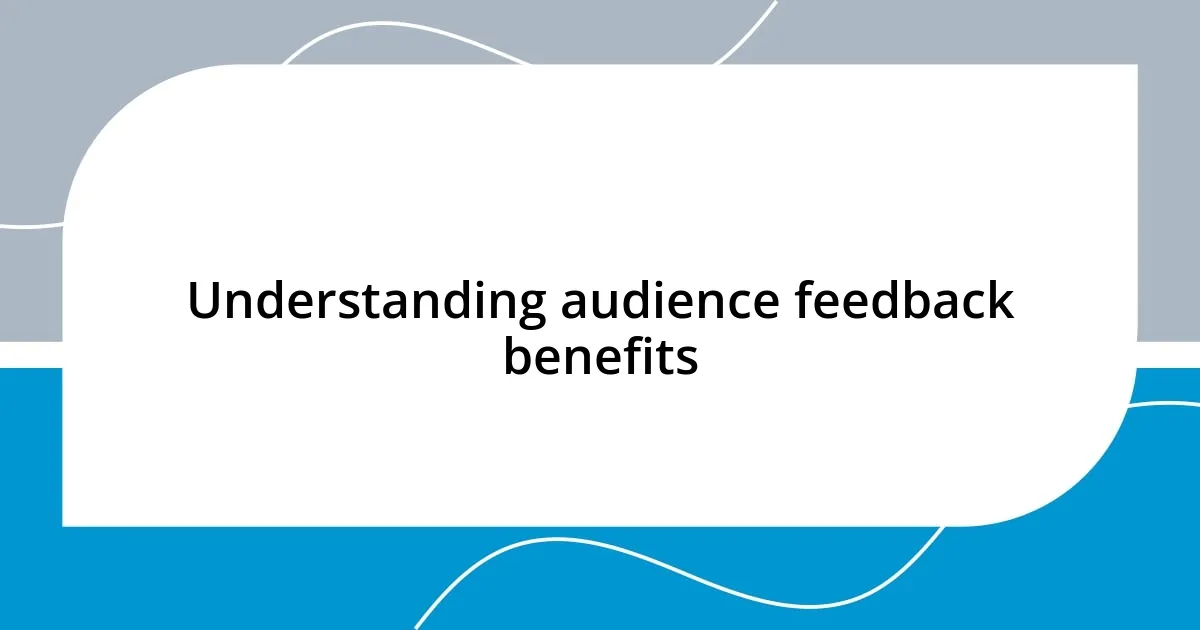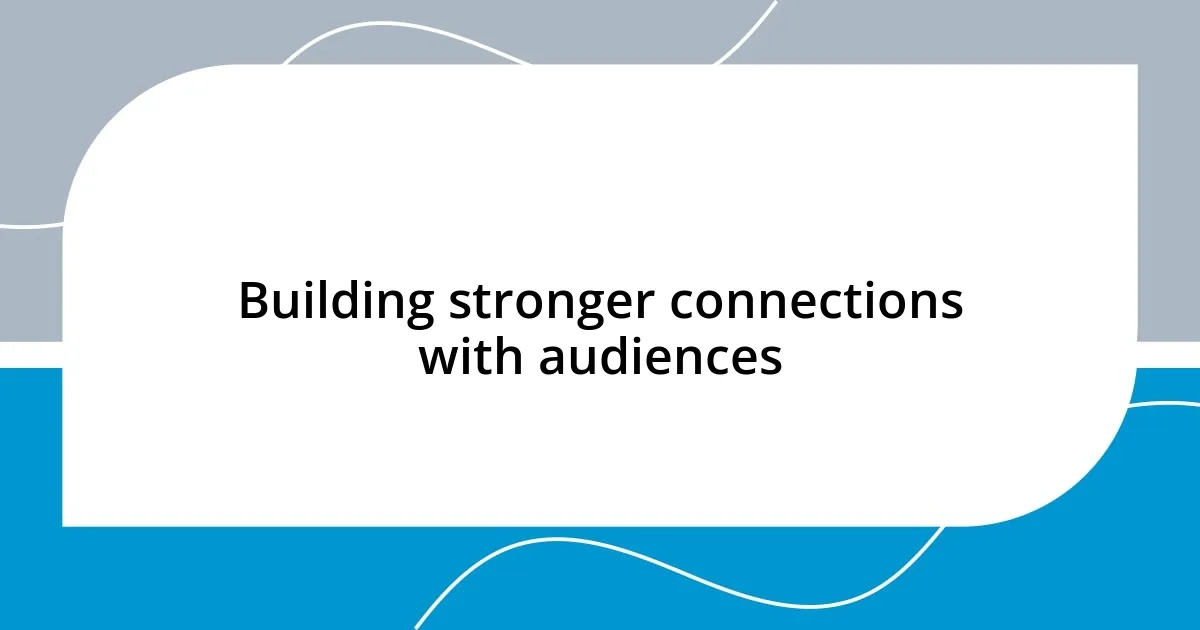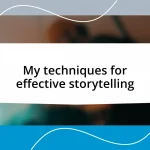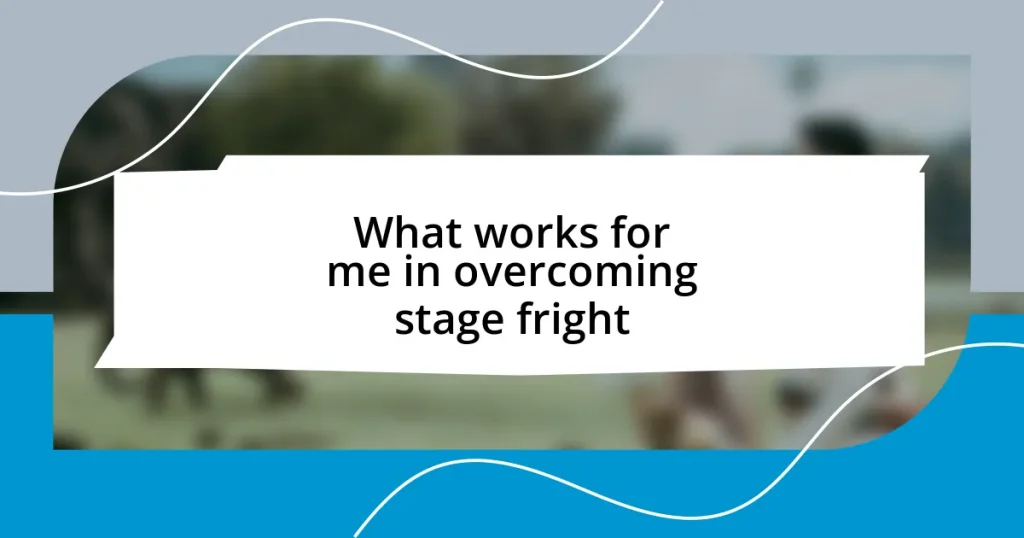Key takeaways:
- Embracing audience feedback deepens connections and fosters a collaborative atmosphere, enhancing the exchange of ideas.
- Different types of feedback, such as direct comments and body language, provide valuable insights for improving presentations.
- Adjusting delivery strategies based on feedback, like pacing and real-world examples, significantly enhances audience engagement and understanding.
- Continuous improvement through feedback loops encourages a dynamic dialogue that empowers both the speaker and the audience, leading to richer experiences.

Understanding audience feedback benefits
Understanding audience feedback offers a wealth of benefits that can truly transform your approach. I remember a time when I shared a presentation and felt confident it was stellar, only to receive feedback that highlighted areas for improvement. Initially, it stung, but with time, I realized that constructive criticism was a goldmine for honing my skills.
When I began to embrace audience feedback, I noticed something remarkable: it fostered a deeper connection between me and my audience. Have you ever felt that electric moment when someone nods in understanding or engagement? That’s the kind of synergy that can only blossom when you’re receptive to what your audience is saying. This shared dialogue allows for a richer exchange of ideas and creates a sense of partnership.
Moreover, audience feedback can be a compass guiding you toward areas of innovation. I’ve often found that when listeners suggest new perspectives or ask probing questions, it opens the door to fresh ideas I hadn’t considered before. Isn’t it amazing how one person’s insight can lead to an entirely new direction? This not only enhances the content but also keeps it relevant and dynamic, ultimately benefiting everyone involved.

Types of audience feedback gathered
When I reflect on the various types of audience feedback I’ve gathered, several standout methods come to mind. Each offers unique insights that can truly shape our understanding. For instance, live reactions during a presentation, like audience laughter or facial expressions, are instant indicators of engagement. I’ve often found that watching people lean forward in their seats as I speak is much more telling than any post-event survey.
Here are some common types of audience feedback I’ve encountered:
- Direct verbal feedback: Comments received right after a talk, often candid and spontaneous.
- Body language signals: Observing nods, smiles, or frowns during the presentation, which can reveal true feelings.
- Post-event surveys: Structured questions that provide quantitative data on specific aspects of the presentation.
- Social media interactions: Online comments or shares that reflect wider audience opinions and insights.
- Focus groups: Small gatherings of participants who provide in-depth feedback on your content and delivery.
Embracing this feedback has opened my eyes to different perspectives. I once received a particularly thoughtful comment about simplifying complex ideas. It prompted me to re-evaluate my approach, leading to clearer, more impactful communication in future presentations. The emotional connection I felt hearing that feedback—knowing someone truly cared about understanding—has stuck with me ever since.

Analyzing feedback for actionable insights
Analyzing feedback is like diving into a treasure trove. I remember a presentation where I anticipated applause, only to be met with mixed reviews. As I sifted through the comments, it struck me how much informative chaos was hidden within. I began to categorize feedback, identifying recurring themes that resonated with my audience. This careful analysis unveiled patterns I hadn’t noticed before—specific suggestions that could elevate my future work and spark new ideas.
Conversely, some feedback can be vague, leaving me pondering its meaning. For instance, a simple “It was good” doesn’t offer much for improvement. Initially, this used to frustrate me; however, I learned to probe deeper. I started asking my audience for specific areas they thought could be improved. This shift fueled more meaningful conversations. Can you relate? Seeking clarity transformed our interactions, making it easier for me to create content that genuinely connected with their needs.
To illustrate how feedback can be compared and analyzed, let’s take a look at different types of feedback and their implications for actionable insights:
| Type of Feedback | Actionable Insight Potential |
|---|---|
| Direct Verbal Feedback | Often provides immediate reactions and specific suggestions for improvement |
| Body Language Signals | Can indicate areas of high engagement or confusion, prompting deeper exploration of content |
| Post-Event Surveys | Quantitative data helps identify trends and common concerns among audience members |
| Social Media Interactions | Broad feedback reaches beyond the immediate audience, reflecting perceptions and potential improvements |
| Focus Groups | Allows for in-depth discussion, revealing nuanced insights that can inform significant content changes |

Adjusting strategies based on feedback
It’s fascinating how adjusting strategies based on feedback can dramatically shift the outcome of future presentations. I recall a time when I received feedback that my pace was too fast, which didn’t allow the audience to digest the material fully. After reflecting on this comment, I slowed my delivery in subsequent talks, and the connection with the audience felt more genuine. Have you ever noticed how a slight change can lead to greater understanding?
Another memorable instance happened during a workshop. A participant pointed out that my examples lacked real-world relevance. I took this to heart and began weaving in more relatable stories from my own experiences. As a result, attendees began to engage much more actively, sharing their thoughts and asking questions. Isn’t it amazing how personal anecdotes can bridge the gap between speaker and audience?
Lastly, there was an occasion when social media reactions to my presentation yielded surprising insights. Many people praised the visual aids I used, while others felt they were overwhelming. This duality prompted me to rethink my approach to visuals, aiming for a clearer balance. It’s a reminder that audience feedback isn’t just helpful; it can be transformative. How often do we really consider these reactions beyond the immediate moment?

Building stronger connections with audiences
Establishing a genuine connection with my audience has been one of the most rewarding aspects of my work. I vividly remember a feedback session where an attendee shared how a story I told resonated deeply with their own struggles. It was a simple yet powerful moment that made me realize the importance of sharing relatable experiences. Have you ever felt that spark of recognition when someone tells your story back to you? That’s the kind of bond I aim to create with every piece I deliver.
In another instance, I tried an interactive Q&A segment at the end of my presentation. Initially, I was met with silence, but then, slowly, hands started to raise. The conversations that followed were enlightening, filled with questions I hadn’t anticipated but which clearly mattered to my audience. This experience highlighted a crucial lesson: inviting dialogue not only fosters a sense of community but also enriches my understanding of their perspectives. Have you ever felt the energy shift in a room when people start to connect over shared questions?
Reflecting on my journey, I find that empathy plays a vital role in building these connections. By putting myself in my audience’s shoes and genuinely considering their viewpoints, I can tailor my content more effectively. When I incorporated audience stories and feedback into my delivery, something magical happened; I noticed a wave of nods and smiles that indicated understanding and relatability. Isn’t it fascinating how understanding someone else’s viewpoint can transform mere presentations into heartfelt conversations? That’s the connection I strive for, and it continually fuels my passion for engaging my audiences on a deeper level.

Measuring the impact of change
Measuring the impact of change is a crucial aspect of refining my presentations. I remember a time after a major shift in my delivery style; I encouraged more audience participation. Following that session, I collected feedback through a simple survey. The difference was noticeable—the responses reflected a stronger connection and engagement levels that exceeded my expectations. Isn’t it satisfying when metrics validate your instincts for improvement?
In another instance, I implemented visual storytelling techniques based on prior critiques. A few weeks later, during a follow-up workshop, several participants approached me, excited to share how those visuals had made complex ideas easier to grasp. Their enthusiasm reinforced that change can ripple throughout the audience’s comprehension. Don’t you find it rewarding when you see the tangible benefits of your adjustments?
Finally, I’ve learned that observing audience reactions is just as important as formal feedback. During one presentation, I noted the expressions on participants’ faces. Several seemed puzzled, leading me to realize my explanations needed more clarity. By later adjusting my phrasing and pacing, I witnessed a visible shift in their engagement. Have you ever felt that moment when you know you’ve finally connected the dots for your audience? It’s moments like these that highlight the powerful impact of being aware and responsive to the audience’s needs.

Continuous improvement through feedback loops
When I think about continuous improvement through feedback loops, I can’t help but recall a recent workshop where participants shared their thoughts on my content delivery. Initially, I felt apprehensive about receiving critiques, but I discovered a treasure trove of ideas that helped me fine-tune my approach. Isn’t it amazing how a willingness to listen can unlock new perspectives that were previously hidden?
I’ve also experimented with follow-up discussions after my sessions, inviting attendees to share their immediate reactions. One time, a participant’s candid feedback about pacing opened my eyes to different learning styles. It made me realize how important it is to create space for reflection, allowing my audience to voice their experiences. How often do we forget that our listeners have valuable insights that can significantly influence our growth?
Incorporating feedback loops feels like cultivating a living dialogue. After integrating suggestions from earlier presentations, I witnessed shifts in the atmosphere during my next talk—there was more engagement, and the audience felt empowered to share their thoughts. Have you ever experienced that moment when the collective energy in the room transforms as people feel heard? This is the essence of continuous improvement: adapting and evolving based on the valuable input of those we aim to connect with.














